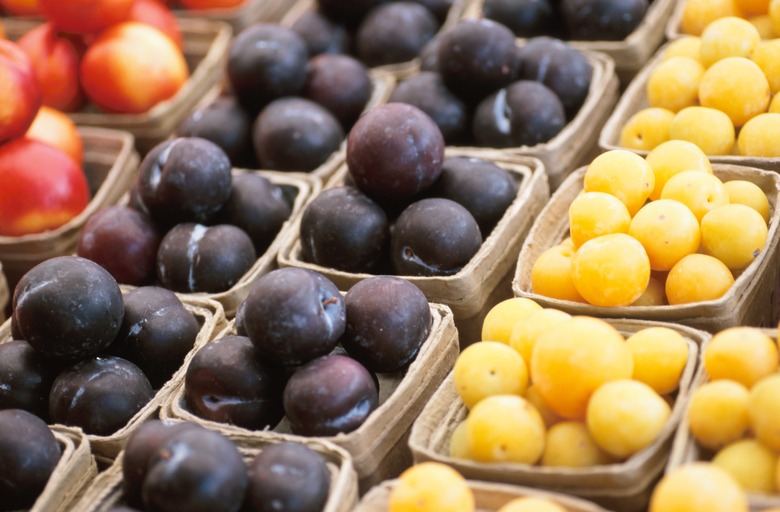When Is A Pluot Ripe?
If you can imagine a fruit that has the texture and appearance of a plum but with the sweetness of an apricot then you're thinking about pluot, a hybrid fruit that is about three-quarters plum and on- quarter apricot. Pluots were created by geneticist Floyd Zaiger, who blended the best qualities of each fruit to create a smooth, firm-skinned fruit with a higher sugar content than plums or apricots alone.
Taste and Smell
Ripe pluots taste like plums but are less acidic, thanks to their apricot parent. They also have a noticeable fragrance when ripened. Depending on the variety, the level of a pluot's sweetness can vary, but typically a ripe pluot has a high sugar content and therefore tastes significantly sweeter than a plum or an apricot.
Color and Size
Pluots come in a range of colors depending on the variety and may be black, crimson, green, plum or yellow. Ripe pluots may have dappled or streaked skins that vary in color as well. The flesh also ranges from white or yellow to reddish pink. For example, when ripe, Candy Stripe pluots are medium-sized, and will have pinkish yellow striped skin which gives them the name. Cherry pluots are small with red skin and white flesh, while a Dapple Dandy is larger with pale greenish-yellow skin that is spotted, or dappled. The flesh of a Dapple Dandy is pink to red in color. Although you may find pluots from May through September, each variety has a relatively short season, so depending on the time of the year you might find more of one color than another. As long as the color is rich and vibrant, then the pluot is usually ready to eat.
- If you can imagine a fruit that has the texture and appearance of a plum but with the sweetness of an apricot then you're thinking about pluot, a hybrid fruit that is about three-quarters plum and on- quarter apricot.
- Depending on the variety, the level of a pluot's sweetness can vary, but typically a ripe pluot has a high sugar content and therefore tastes significantly sweeter than a plum or an apricot.
Texture
A firm, plump pluot is typically ripe enough to eat. When you press on the stem end, the fruit should give slightly. However, pluots are fragile when ripe, so don't press too hard when checking for ripeness or they will bruise. The flesh of a ripe pluot is also juicy and sweet, similar to that of a plum. If you bite into a pluot that is not soft and juicy, it is not ripe. If the texture of the pluot is mushy and soft when you pick it up, it may be too ripe.
Storage
If you've purchased pluots that aren't quite ripe, store them in a paper bag at room temperature and check them daily. They'll ripen after a few days in the bag. Do not stack them in the bag or they may bruise. Ripe pluots are ready to eat and will keep for a few days if stored in the refrigerator.
- A firm, plump pluot is typically ripe enough to eat.
- However, pluots are fragile when ripe, so don't press too hard when checking for ripeness or they will bruise.
